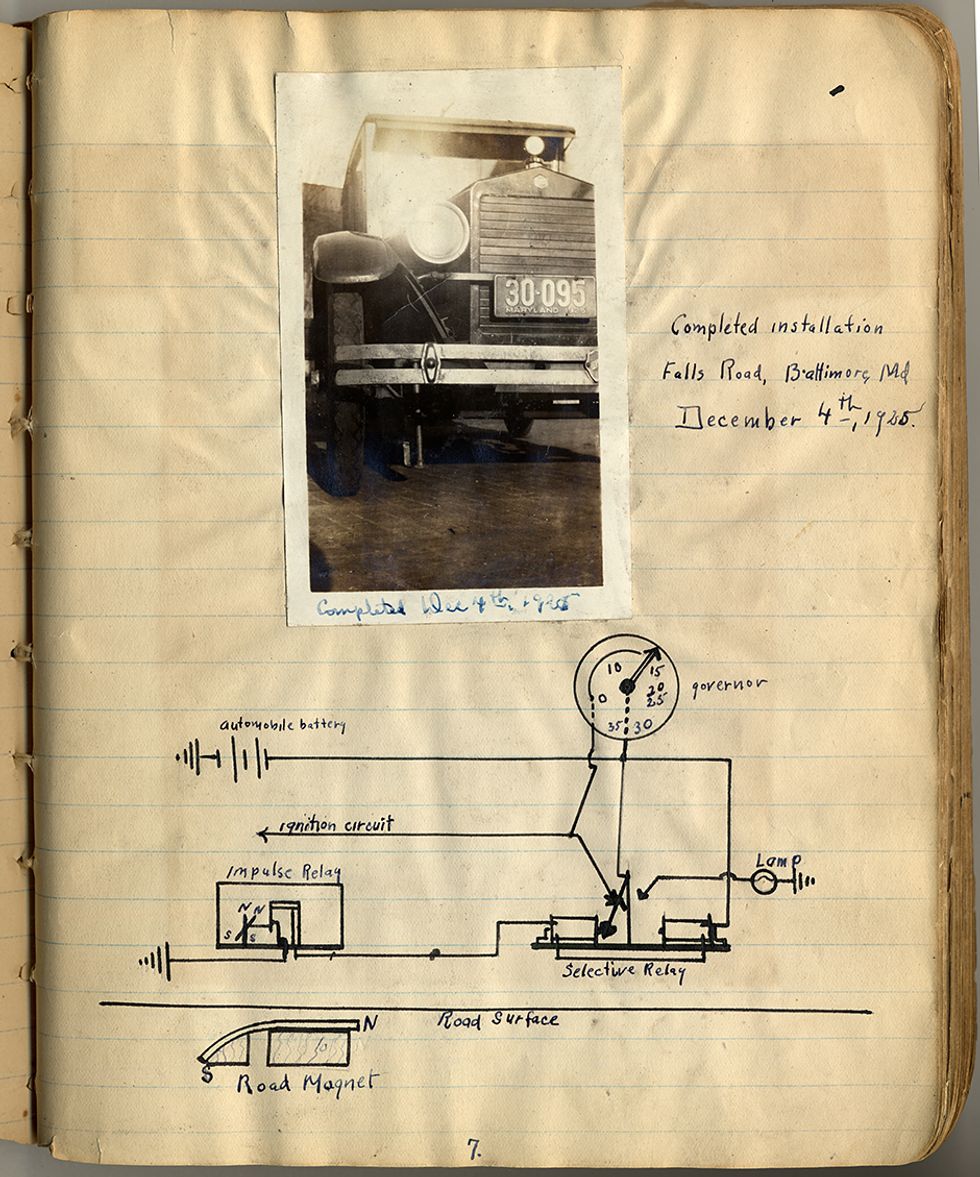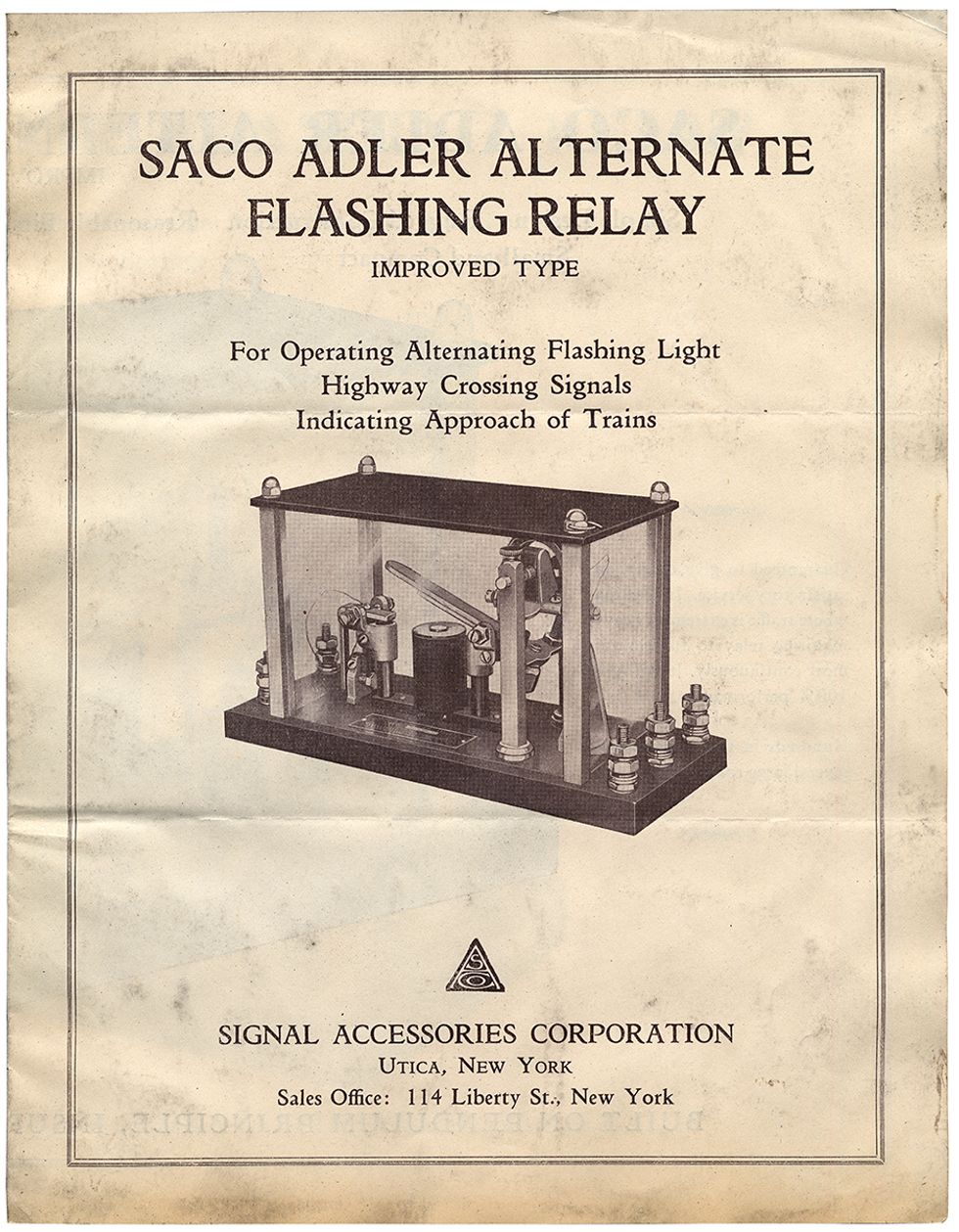The Man Who Invented Intelligent Traffic Control a Century Too Early
With traffic accidents soaring, Charles Adler imagined an intelligent transportation system that was ahead of its time
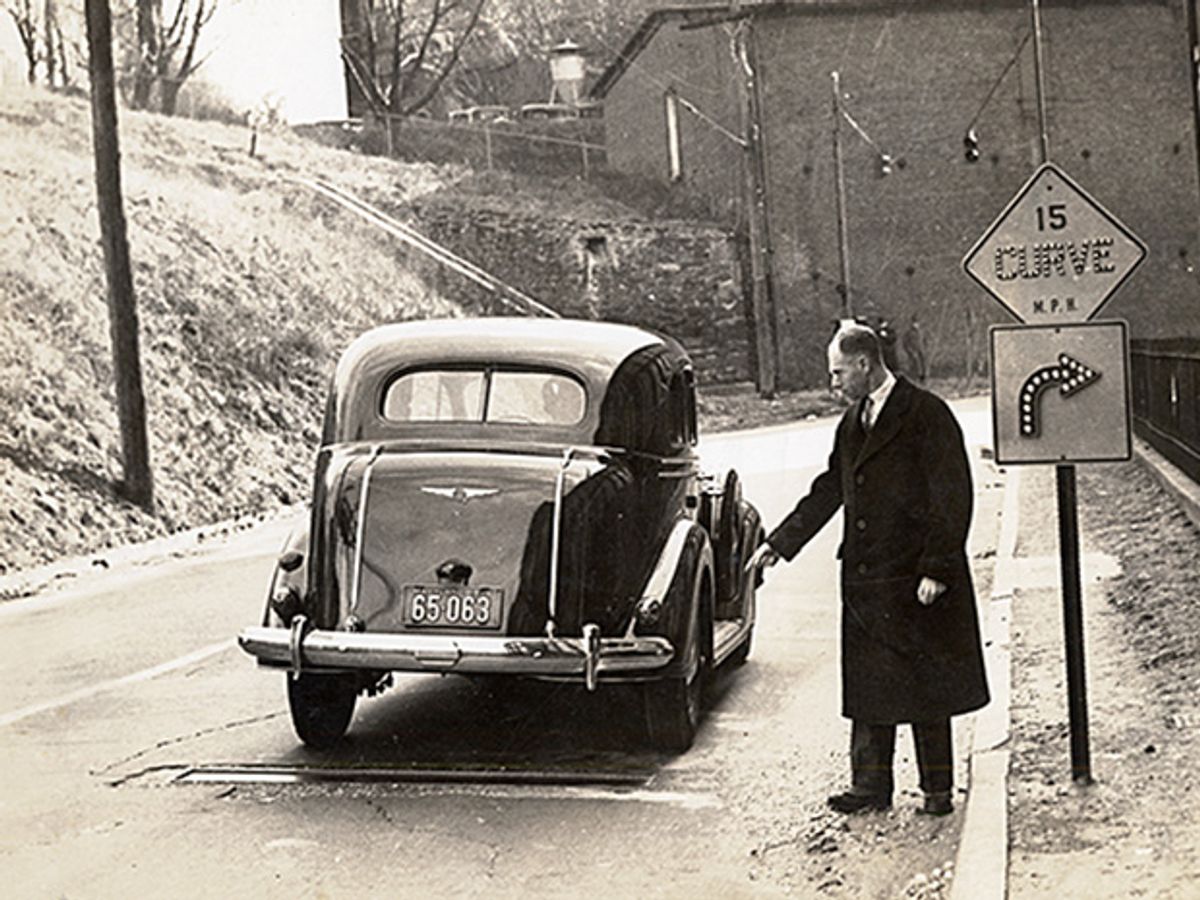
On a cool December day in 1925, Charles Adler Jr. stood beside Falls Road, a state highway on Baltimore’s north side. He was there to test his latest invention: an electromagnetic apparatus that would automatically slow cars traveling at unsafe speeds. Adler had embedded magnetic plates in the road where it led into a precarious curve, and he was now waiting for a specially prepared car to drive over the magnets. The magnets would activate a speed governor connected to the vehicle’s engine, slowing it to 24 kilometers per hour.
Adler had developed this automatic speed-control system for railroad crossings, the scene of many deadly accidents at the time. But he soon came to imagine all sorts of applications for it: “Dangerous road intersections, streets on which schools are located, bad curves, and even steep down grades,” according to an article in the Baltimore News.
On that December day, the test vehicle drove down Falls Road as Adler and his supporters looked on. The magnets tripped the governor, cutting the car’s speed; the demonstration went off without a hitch. Adler spent the next year promoting his invention and attracting investors. He had good reason to be hopeful: With traffic accidents soaring throughout the United States, communities were clamoring for solutions. Several years earlier, a road signal he’d designed for train crossings had been readily adopted by 40 railroad companies nationwide.
After little more than a year, however, Adler’s efforts had led nowhere. Over the next decade he continued to refine his designs and devise new ones, but his many inventions to make roads safer never saw widespread adoption.
Today, Adler’s automatic speed-control system looks like an early version of a smart road or an intelligent transportation system. These sensing and communications systems inform drivers, or fully autonomous cars, of conditions on the road ahead, thereby boosting both safety and efficiency. Such a system might automatically drop a car’s speed as it approaches stalled traffic, an accident, or a dangerous intersection, much as Adler sought to do. Indeed, he looks like a man before his time. Understanding just why Adler failed can tell us much about the nature of innovation and the acceptance of new ideas.
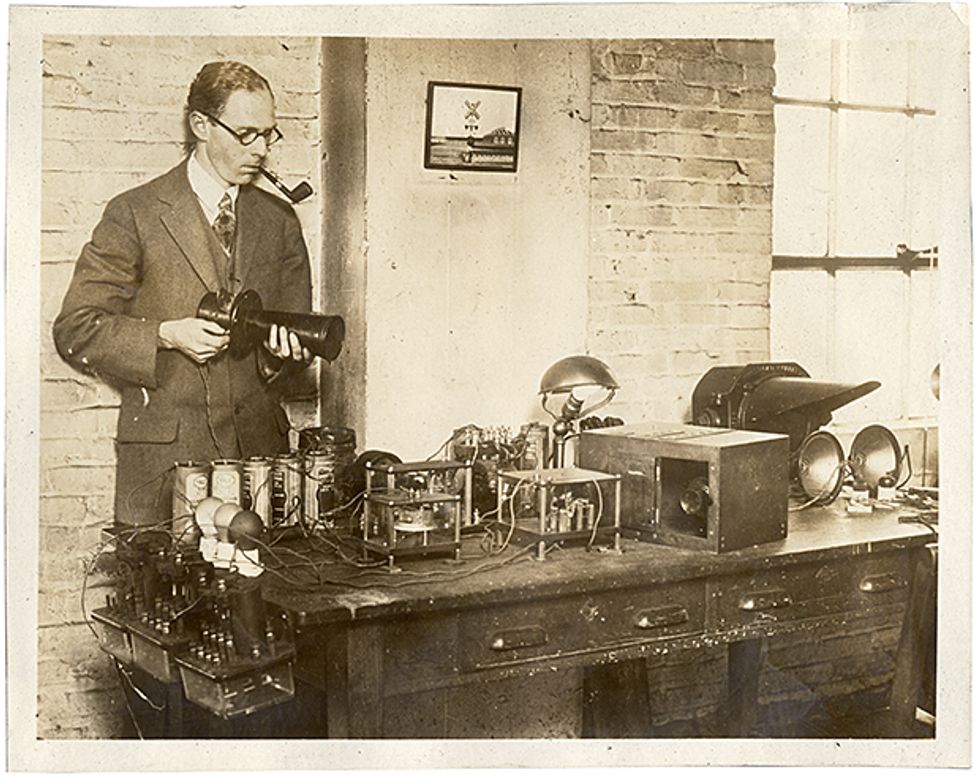
In 1899, the year Adler was born, Henry H. Bliss became the first American to die in a car accident, when an electric taxicab ran him over in the streets of New York City. From then on, traffic deaths quickly mounted. In 1913, when there were 1.26 million cars on U.S. roads, 4,200 people were killed in auto accidents; by 1925, when Adler ran his experiment, fatalities had more than quintupled, to 21,900.
Such problems went well beyond U.S. borders, of course. Indeed, they arose wherever there were cars. Back in 1869, Irish scientist Mary Ward had been run over by an experimental steam car, becoming the first person in the world to die in an automobile accident.
As the death toll rose, so did public outcry. In 1920, the Chicago Tribune began running a daily column detailing auto deaths around the city. In addition, many U.S. cities were snarled with traffic jams. The entire automotive system—roadways, intersections, bridges, and other supporting infrastructure—was a mess.
Progressive legislators and activists set about to reform the automotive world. Some U.S. cities and states began requiring vehicle owners to get brake and headlight inspections and obtain auto insurance. The first electric traffic signals appeared, with early ones installed in Salt Lake City in 1912 and Cleveland in 1914.
Entrepreneurs sensed opportunity, and new companies as well as established firms scrambled to promote competing systems. One result was a confusing proliferation of disparate traffic control signals and signs. Many of these look completely foreign to our eyes today. The Milwaukee Mushroom, for instance, was a colander-like metal grate that was placed in the center of an intersection and guided drivers who were making left turns around the center point, rather than letting them cut tightly through the intersection. When New York City switched on its first electric traffic signals along Fifth Avenue in 1921, yellow meant traffic on Fifth Avenue could move, while cross traffic from side streets stopped; red meant all traffic stopped, on Fifth Avenue as well as the side streets; and green meant traffic from only the side streets could proceed.
Adler was one of the inventors who rushed into this emerging world. Born to a wealthy family in Baltimore, he attended the prestigious Park School but struggled academically. “Because of my low grades, my father thought that I might be mentally retarded,” Adler later wrote. His father took Charles to see a psychologist, who said, “You have a remarkable son [with] a vivid imagination. He should be encouraged to invent.”
Adler demonstrated technical acumen early on. When he was just 14, he created an electric automobile brake and received a patent for it five years later. After serving in World War I, he briefly studied engineering at Johns Hopkins University, but his difficulties with school continued, and he soon dropped out.
He hardly looked or acted like a college dropout. Even as a young man, Adler dressed impeccably and often smoked a pipe; a journalist would later remark that he “might actuate a few signals with his sartorial splendor.” Nor did Adler lack for confidence, proudly writing to others about his newest inventions even before he had much to show. Later in life, he had professional photos taken of himself posing with his cars—Corvettes, Maseratis, Cadillacs, MGs, even a Rolls Royce.
In early 1919, Adler found a job with the Maryland and Pennsylvania Railroad. The president of the railroad, O.H. Nance, learned of Adler’s teenage electric brake invention from an article Adler wrote for the Maryland Motorist. Intrigued, Nance asked Adler to look into a persistent problem: The Ma & Pa had installed electric warning signals at grade crossings, where roads met railroad lines, but the signals were failing regularly. Adler quickly worked up a solution that involved a new type of relay and a light connected in a series with a bell. Even if the bell failed, the light would still illuminate. The invention worked, and Adler was promoted to signal engineer and given an office and a laboratory for his experiments.
Adler’s first major project was a new type of flashing signal for grade crossings. At the time, many cars didn’t bother to stop at railroad crossings, with the unsurprising result that about 1,500 people were dying in car-train collisions every year. The eventual solution was to eliminate grade crossings wherever possible by placing rail lines above or below the road. In the meantime, the American Railway Association (ARA), the trade group for the U.S. railroad industry, directed its member companies to install some sort of flashing light at such intersections.
The system that Adler designed was triggered automatically by the train as it approached the intersection. Two lights would flash in an alternating pattern, known as a wigwag, which mimicked the way a man swinging a lantern might warn oncoming cars. Adler’s flashing signal received the ARA’s endorsement, and more than 40 railroad companies adopted it.
Adler’s ambitions went well beyond railroad signals, however. In 1930, with money from his family, he left the Ma & Pa to pursue invention full-time.
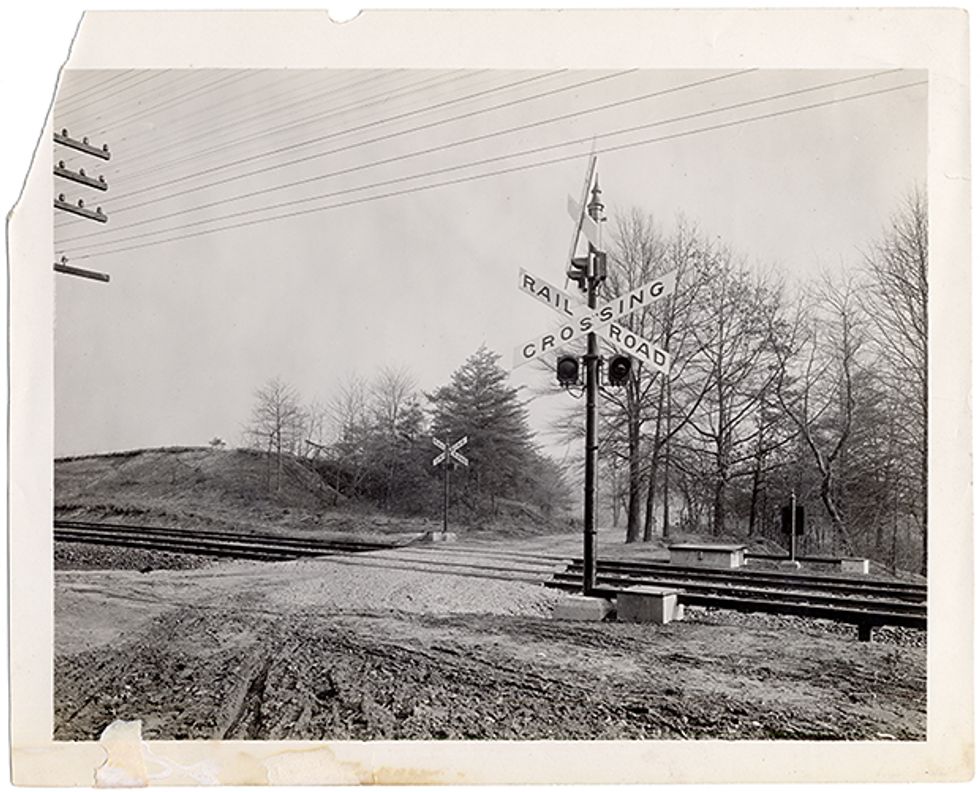
Even before he quit the railroad, he conceived the automatic speed-control system. It first occurred to him on 1 October 1924, as he recounted in his meticulously maintained lab notebook. He no doubt drew inspiration from automatic train controls, a technology for limiting a train’s speed that didn’t rely solely on the driver. The idea had been around since the mid-19th century but had not been widely adopted. (Indeed, as recent fatal derailments in Spain and Philadelphia remind us, automatic train controls are still not as common as they should be.)
Adler was also familiar with speed governors in cars and the controversy the technology had stirred up. A year earlier, 42,000 people had signed a petition in Cincinnati, calling for speed governors on all cars to limit them to 25 miles per hour or less. But after motorists from around the nation fought the proposal, it was defeated. Adler believed his system, which activated the speed governor only at particularly dangerous spots, would prove more palatable.
The system that Adler demonstrated on Falls Road worked like this: A series of bar magnets were buried beneath the road 20 meters or so from the danger point. The magnets ran parallel to each other and to the road, angled downward so that their north poles were closest to the surface of the road. The test car, meanwhile, had a small relay with a needle magnet (like the needle on a compass) affixed near its front axle. As the vehicle reached the road magnets, the needle magnet would swivel, momentarily opening the relay, which was connected to another, more substantial relay.
That second relay sat in a box beneath the hood and was connected to the car’s ignition switch and a speed governor. The relay consisted of two coils mounted on opposite sides of a pendulum, which acted as an armature between the two coils. When the pendulum rested on one coil, it closed a circuit that allowed the current operating the car’s ignition to flow normally. When the pendulum received a pulse of electricity from the needle-magnet relay, it swung to the other coil, forcing the ignition current to travel through the speed governor. At speeds of 24 km/h or less, the speed governor would allow the current to flow through the ignition system to the car’s spark plugs; at any greater speed, the current would be cut, and the car would decelerate. Finally, the car would pass over a second set of magnets buried in the road, and another pulse from the needle-magnet relay would cause the pendulum to swing back to the other coil, restoring the ignition current. (The pendulum armature was basically like an electromechanical flip-flop switch.)
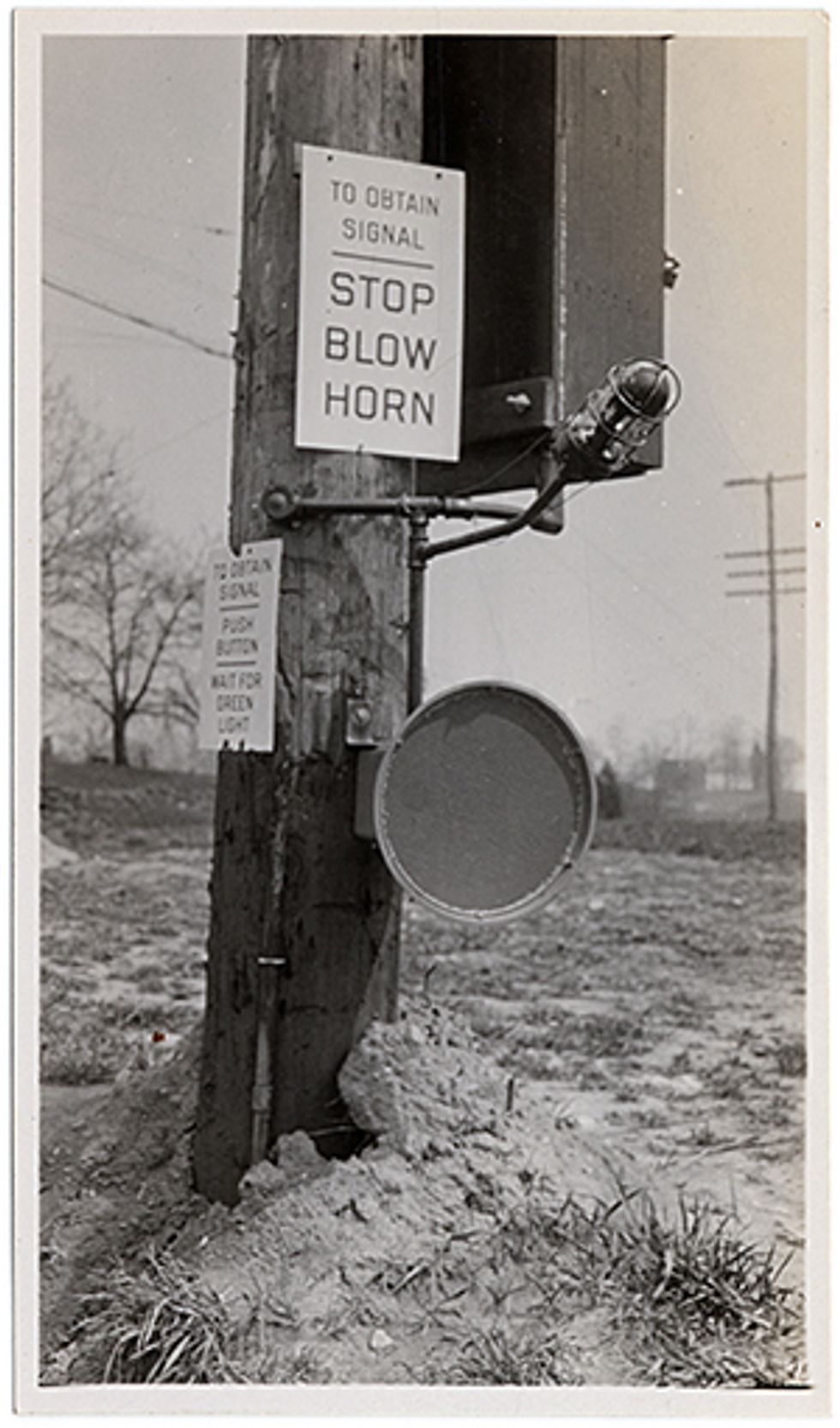
Adler knew he’d have to spend considerable energy promoting his idea. He belonged to what the historian Eric Hintz has called the “post-heroic” generation of inventors, who followed on the heels of Thomas Edison and Alexander Graham Bell. Though the public still revered such engineering icons, being a lone inventor in the early 20th century was hardly glamorous. By then, large corporations were internalizing the act of invention by creating R&D labs. As organized research became the order of the day, independent inventors increasingly looked to license their patented creations, rather than attempting to manufacture the technology themselves. Corporations were naturally reluctant to license outside technologies—why else have an internal R&D lab?—so inventors had to publicize their technologies to have any hope of success.
In the months following his October 1924 inspiration, Adler began designing the components of his system and also selling the idea to others. He kept scrapbooks recording his promotional efforts in as much loving detail as he did the technical aspects of his inventions. He discussed his idea with contacts in the railroad industry, including the signal engineer and the vice president in charge of maintenance and safety for the Baltimore and Ohio Railroad, as well as A.H. Rudd, the chief signal engineer for the Pennsylvania Railroad, who at the time was the most influential signal designer in the country; all reacted enthusiastically. In January 1925, Adler gave a talk at a joint meeting of the National Safety Council and the American Society of Safety Engineers, in Baltimore. And he contacted more than 600 newspapers, magazines, and engineering journals around the United States; hundreds of them ran stories on Adler’s idea, including Popular Science Monthlyand the New York Evening Post. But Railway Age, the industry’s chief journal, rejected an article from Adler.
He didn’t stop there. Adler had seen how the American Railway Association’s endorsement had gotten dozens of railroad companies to adopt his wigwag signal. And so he looked for a comparable authority to back his speed control system. Secretary of Commerce Herbert Hoover, an engineer by training, had recently created the National Conference of Street and Highway Safety [PDF] to address the deadliness of U.S. roadways. It was the first federal effort to promote automotive safety. The conference brought together railroad, streetcar, and automobile company executives, education experts, statisticians, actuaries, and others, who met regularly to study ways to decrease accidents. The group put forward a number of noteworthy solutions, including a standardized set of traffic laws.
Adler contacted Ernest Greenwood, who ran the day-to-day operations of the conference; he heartily endorsed Adler’s plan. Encouraged, Adler sent reprints of an article he’d just published in the journal Safety Engineering to the conference’s 600 delegates.
But Adler had misunderstood the basic nature of the conference. Hoover eschewed federal regulation, preferring to let corporations and state and local governments take action voluntarily; he’d created the conference in this spirit. Even if he’d felt otherwise, no federal law or rule gave Hoover the power to regulate automotive design or highway construction. Adler’s invention required coordination among several levels of government and the car industry. Without an authority to mandate speed governors in automobiles and magnetic plates in roads, the system wouldn’t function. Federal regulations over automobiles and highways wouldn’t become law for another 40 years.
Adler was undeterred. By May 1925, he’d gathered a group of financial backers. On the heels of his successful December 1925 test, he continued to demonstrate the system for journalists, signal makers, police chiefs, state motor-vehicle administrators, and potential investors. He suggested that local authorities could defray the cost of installing the magnets by selling advertising space on the same signs that warned drivers of the danger points. He argued that the installation of speed governors could be made a requirement in annual vehicle inspections.
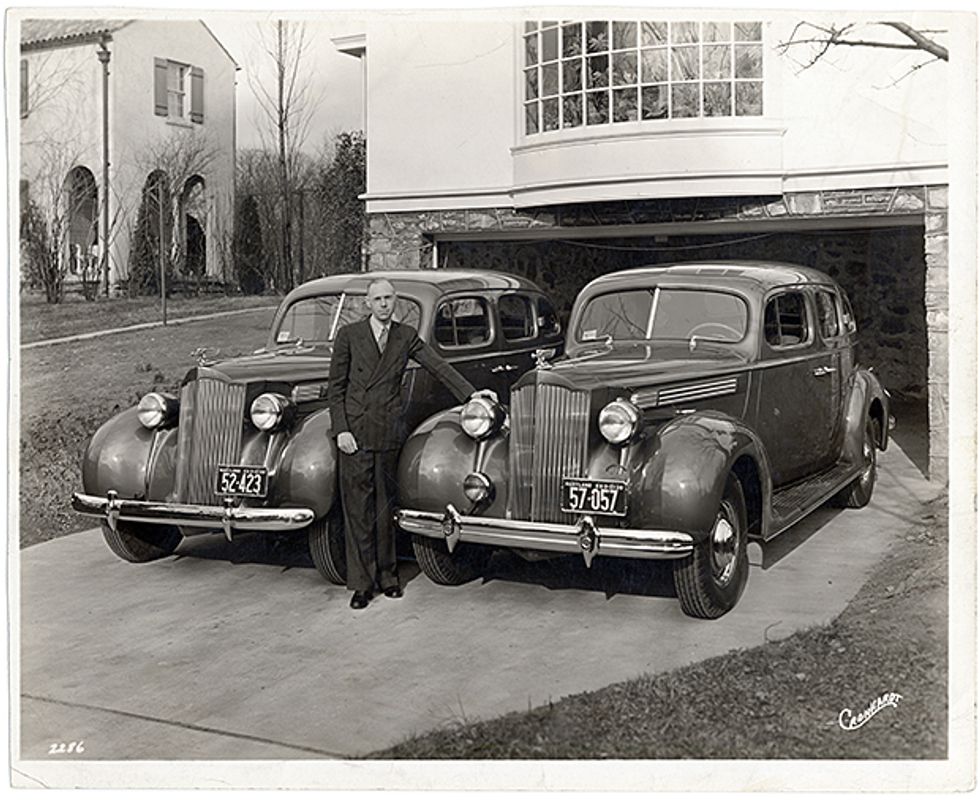
Adler tried in vain to interest automakers in his idea. He thus began in mid-1926 to shift his focus from automobiles to buses and commercial vehicles. Conversations with insurance executives led him to believe that insurance premiums would create a strong incentive for commercial fleets to adopt the system. “The reduction of insurance by use of apparatus should more than compensate the bus company for use of the same,” he wrote in his notebook.
It wasn’t just wishful thinking. During this period, the U.S. Post Office Department and other organizations that owned large numbers of cars and trucks were installing speed governors on their vehicles. (A few companies, like the pest-control company Orkin, still do so.) Adler did convince two bus companies in Maryland to install his system for demonstration purposes.
The inventor also continued to revise the technology, promoting an “automatic dashboard signal unit for pleasure car use.” The magnets in the road would still trigger speed governors on commercial vehicles, but in ordinary cars, they would simply activate a light on the dashboard, warning drivers of the approaching danger point. As Adler reasoned, “The magnets, once installed, would create a market for the automatic dash signals.”
But the steam was running out of Adler’s project. On 15 December 1926, his investors met and decided to suspend work until they could verify that Hoover would promote the system through the national safety conference. He never did. The next month, one investor tried to get permission from the state of Maryland to put up advertisements to cover the costs of the magnets, but even this effort came to naught. In early 1927, Adler stopped recording events in his notebook.
He didn’t give up on trying to automate traffic safety, however. He continued to develop car safety devices, and in the late 1920s, he had minor success with a sonically actuated traffic signal. When a driver pulled up to a red light, honking the horn would make the light change. The system was intended for use at intersections where lightly traveled roads met major thoroughfares and where the traffic light needed to change only when a driver had to cross.
Adler’s sound-triggered traffic signal was picked up by General Electric, which marketed it as part of a bundle of traffic management innovations. But another invention quickly surpassed Adler’s idea; it used two metal plates embedded in the roadway to sense a vehicle’s presence and so required no action on the driver’s part.
Meanwhile, the openness around traffic control systems had closed. By the early 1930s, the traffic-safety technology that we still have today, including three-color traffic signals and standardized street signs, was mostly in place. By the end of that decade, Adler had abandoned his work on road safety and began focusing on aviation safety instead.
Why did Adler’s automatic speed-control system fail? The technology seemed to work, although we can easily imagine its imperfections. What would happen if the device on the car malfunctioned, for example? And what would prevent drivers from simply disabling it? But the barriers to Adler’s system were not primarily technical. What ultimately doomed it was the lack of laws and governmental organizations to mandate the system’s use.
On 3 February 2014, the National Highway Traffic Safety Administration, the U.S. agency created in 1966 to oversee car safety standards, announced that it was considering requiring vehicle-to-vehicle (V2V) communication technologies on all cars sold in the United States. “This technology would improve safety by allowing vehicles to ‘talk’ to each other and ultimately avoid many crashes altogether,” the press release announcing the decision stated. Since then, the agency has worked steadily to promote the technology and the regulation that would make such systems a reality. Many automotive experts believe that the logical next steps after V2V communication will be smart roads and autonomous vehicles, such as Google’s self-driving cars.
Tech companies and carmakers are working hard to bring about this automotive future. And yet, when that future arrives, it will largely be because of federal laws, first passed in the 1960s, that controlled automotive design and highway construction. While today’s carmakers introduce new safety technologies—airbags, antilock brakes, electronic stability control, rearview backup cameras—into luxury lines as sellable features, typically federal action is needed to push such technologies into all new vehicles. Such laws did not exist in Adler’s day. He was indeed ahead of his time, but as his case so poignantly shows, the success of an innovation often depends as much on the quality of our institutions as it does on the quality of the technology itself.
About the Author
Lee Vinsel is a historian of technology at Stevens Institute of Technology, in Hoboken, N.J. Research for this article was conducted at the Smithsonian’s National Museum of American History in Washington, D.C.
